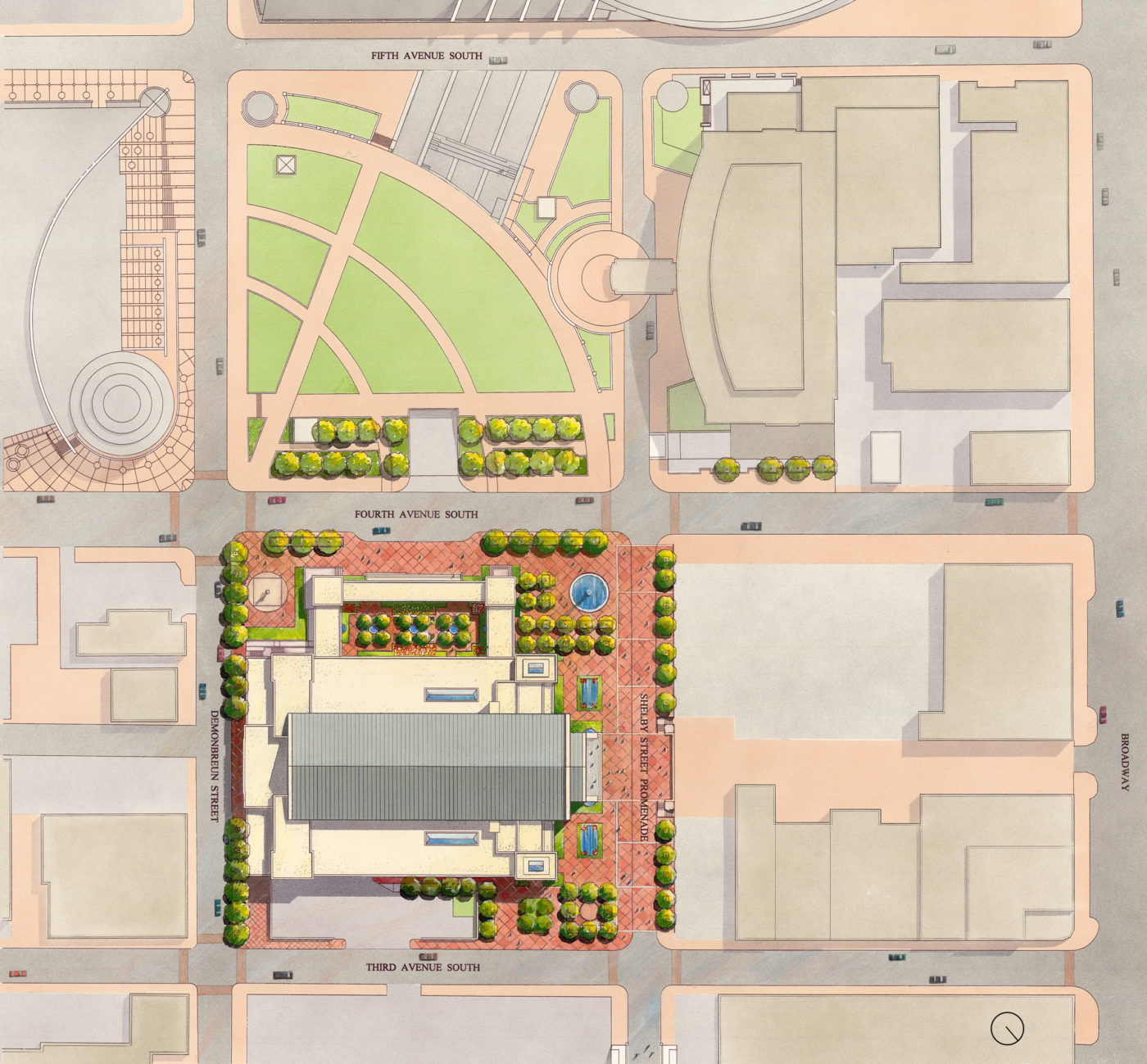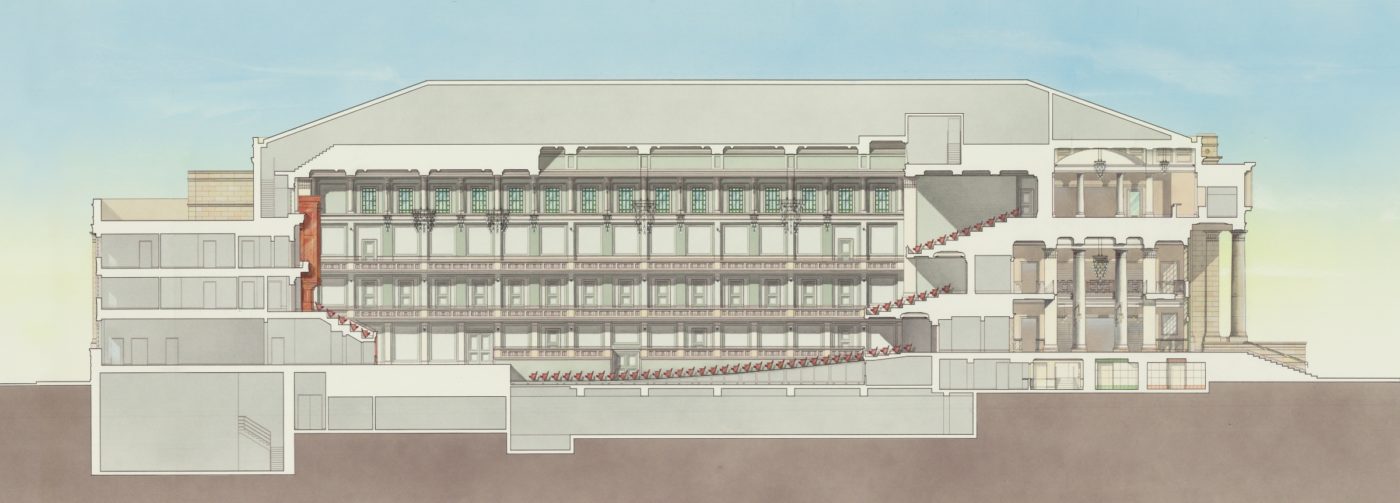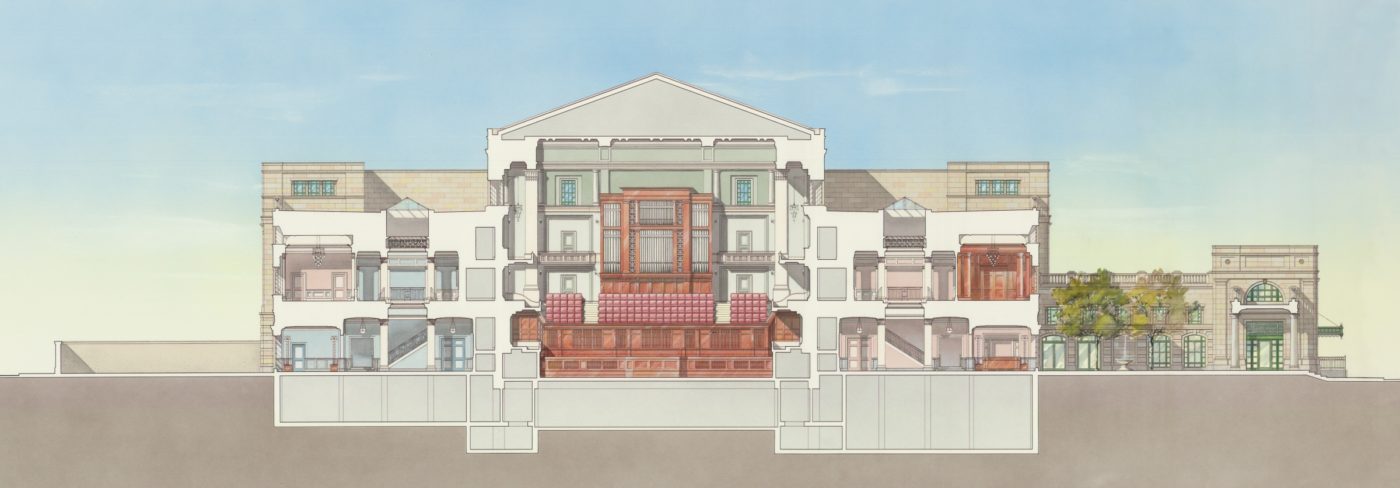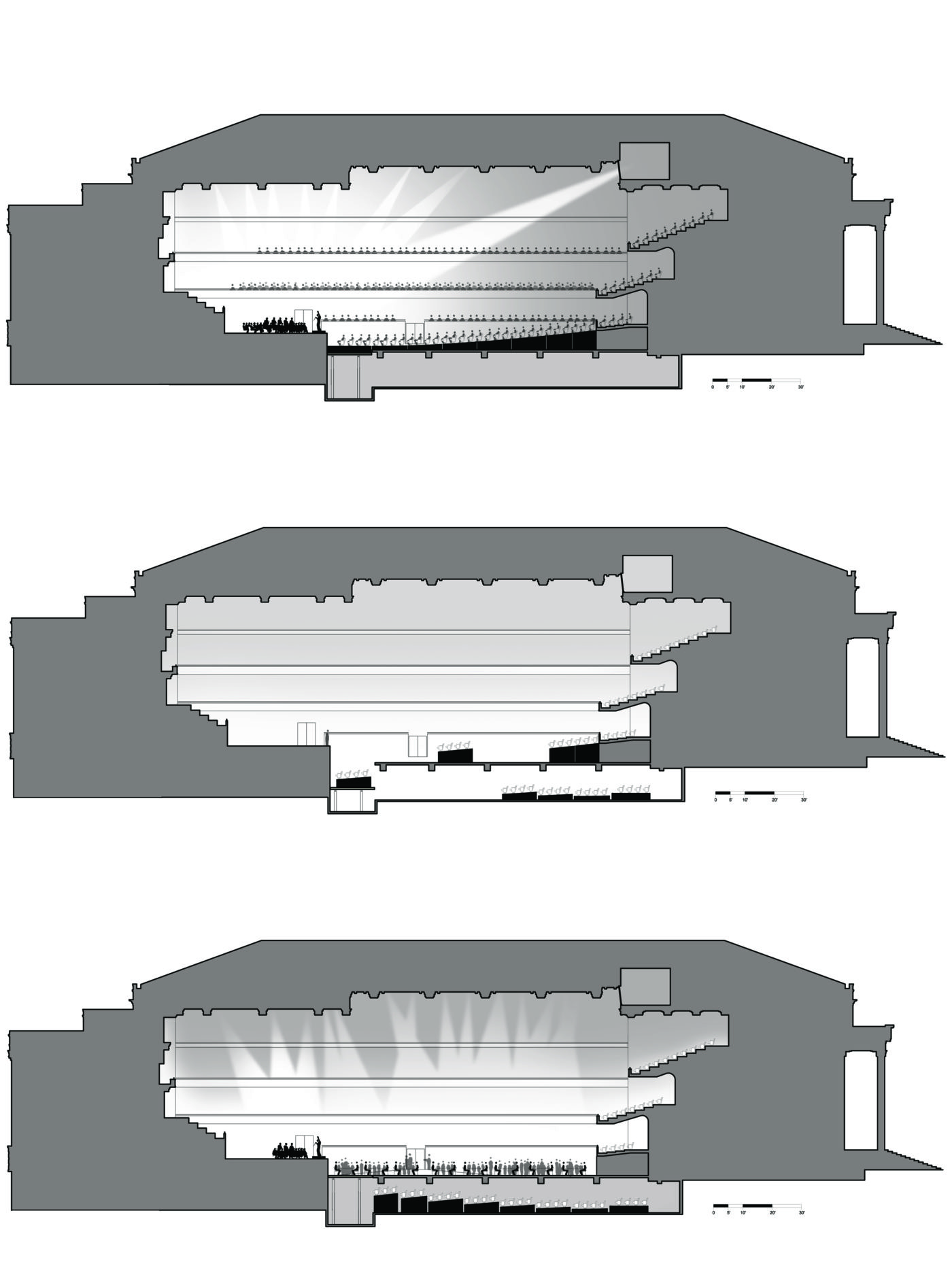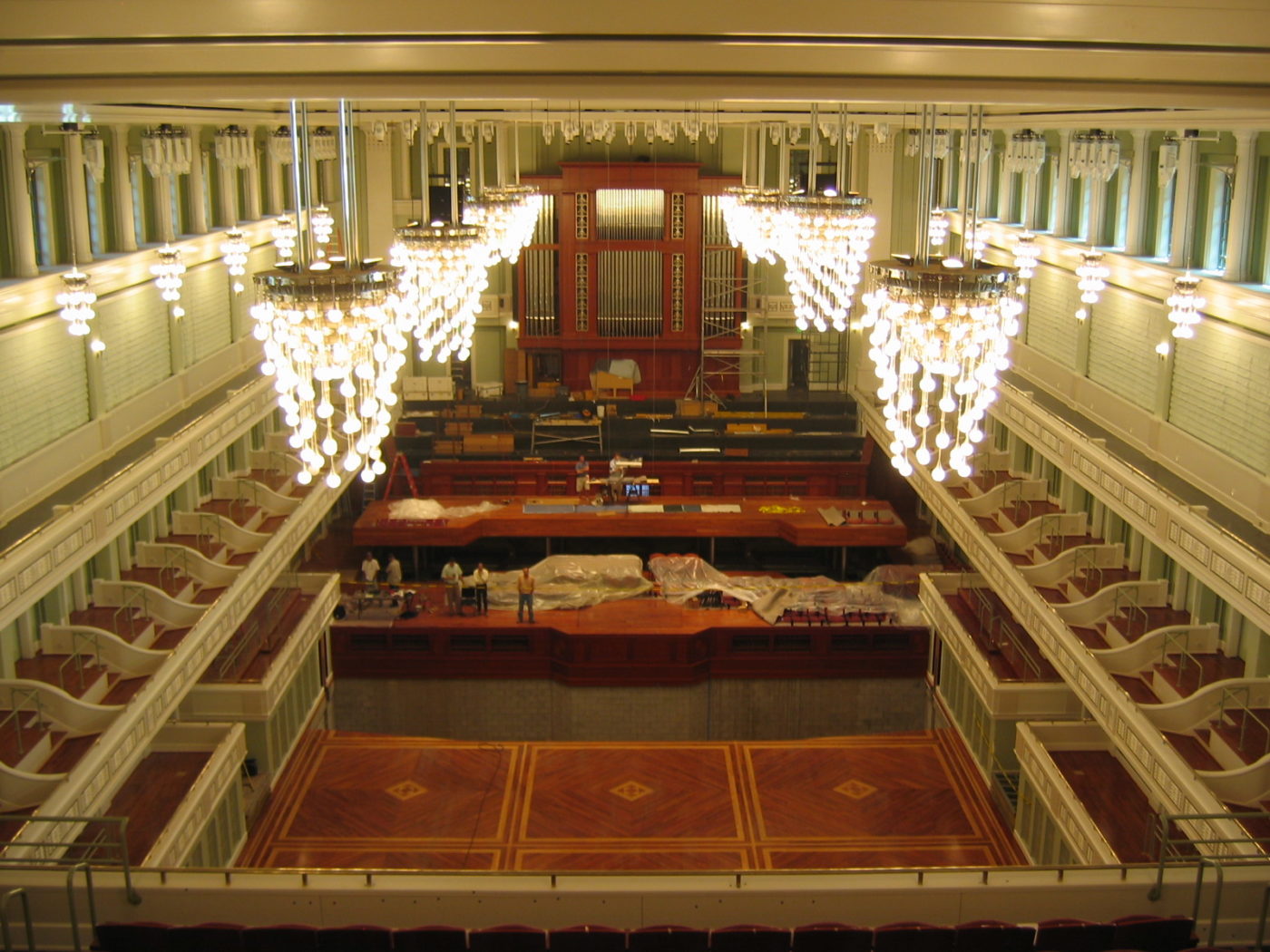The Schermerhorn Symphony Center was named in honor of Kenneth Schermerhorn, the long-term music director of the Nashville Symphony who passed away in April 2005 after celebrating his twentieth year as a music director. Completed in September 2006, Schermerhorn is a 197,000 SF, new-construction hall with top-tier acoustics, rivaling some of the world’s most respected venues.
"...an architectural and acoustic gem and one of the most successful auditoriums built in a century.”
-The Wall Street Journal, 9.12.2006
Building Site
Situated on an entire city-block in the SoBro neighborhood of downtown Nashville, the site presented several complex planning and design challenges. The site faces a new, under-utilized, urban park, fronted on two of its other three sides by relatively aggressive architectural statements. A central question was whether the hall should front on the park to the west, or a planned pedestrian way to the north. The design solution involves a multi-frontal approach whereby a monumental, ceremonial portico entrance faces the pedestrian way, and a colonnaded, formal garden and two flanking wings with end pavilions faces the park. The pavilions house two active, daytime uses – the box office and stage door – to help activate the under-used park.
Athens of the South + Music City
A town of two monikers, Nashville is known as both ‘Music City’, for its long history of producing & nurturing some of the countries great musicians, and ‘the Athens of the South’, for its numerous institutions of higher learning. Reinforcing the later label, the city also possesses a full-scale replica of the Parthenon and a fine collection of significant Neo-Classical architecture. Given this setting and the symphony’s classical repertoire, the client group was predisposed toward a timeless, Neo-Classical building. Buildings, however must reflect their time and age. The design approach achieves a balance between these objectives by reexamining the elements of classicism and reinterpreting them for this specific building.
Rather than simply draping on a literal Neo-Classical style, through dialogue with the client and an in-depth study of the site, the City of Nashville, prototypes of the building type, ideal classical forms, and a large swath of relevant styles, the Schermerhorn Symphony Center design synthesizes the best of the past, along with current technologies and building practices, ultimately achieving a unique design. While reading as Neo-Classical to the casual observer, the building is much more complex upon further study.
The detailing is only classical at its essence, but is actually a modern reinterpretation, only conceivable as part of contemporary architectural discourse. Otherwise traditional detailing of beaux arts precedents are reduced and lightened. The Schermerhorn Symphony Center’s large glassy opening make for a more open and approachable building than either a more conventional approach to the style of the classical music be performed within would suggest.
Progression Through Space
The same design approach was applied to the plan arrangements and interior detailing. The needs of a performance venue - functional to modern standards of comfort and amenity - were accomplished while maintaining a classically-based, ceremonial progression of movement through space. Key to this progression through the front of house is its culmination at the auditorium, which reads as the single most important space, as it should in all performance venues.
From the point of entry at the stage door with its strong street presence, the Schermerhorn Symphony Center’s back-of-house experience is quite different from its predecessors. The entrance opens to a generous, light-filled lobby to greet staff and visitors. A major goal was to avoid the usual tight and cramped warren of spaces commonly associated with back-of-house areas. The rear stage area of the Schermerhorn Symphony Center is quite large, while the orchestra lounge is flooded with natural light and outfitted with large, movable storage tables for instrument layout. To fulfill the client’s program of housing all Symphony and support staff under one roof, the building has over 15,000 square feet of office space on the upper floors, wrapping the auditorium. A 1,200 square foot roof terrace, accessible to musicians and staff alike, is located adjacent to the offices.
Crafting a Concert Hall – Technical Integration & Teamwork
A successful concert hall is the result of a healthy collaboration of acoustician (Akustiks), theater planner (Fisher Dachs Associates) and architect. From the outset, it was the goal of the Schermerhorn Symphony Center design team to seamlessly integrate those elements required for acoustics and performance with the architecture of the auditorium. The room’s shoe box shape, its critical length, height and width dimensions and disposition of balconies, cornices, pilasters and coffer beams all serve to reinforce the sound quality of the room. The highly diffusive surfaces of the auditorium relate to the multi-stepped shaping of the lobby walls to form a coherent and unique architectural vocabulary. The absorptive sound banners and drapes required for amplified performances are incorporated between pilasters, so that the architecture of the room still reads when they are deployed. Much of the technical clutter associated with the theater lighting is tucked into recessed pockets incorporated into the design of the hall ceiling, and the centerpieces of cast ornamental ceiling panels are removable for passing theater rigging lines.
Other Unique Features
One of the most unusual features of the new home for the Nashville Symphony Orchestra is the integration of natural light into the performance space via clerestory windows ringing the perimeter of the hall. While quite common in music halls from the 19th and early 20th centuries, windows are practically unheard of in other contemporary halls. Incorporating natural light proved to be quite a technical challenge, as windows would normally present a weak link in the acoustic isolation of a performance space where keeping out unwanted noise is critical. Each window is a complex assembly comprised of an inner lite of two inch thick glass and an outer, three-inch thick layer, separated by a thirty-inch deep air space.
The hall can be transformed from a traditional raked floor auditorium with 1,000 fixed theater seats at the orchestra level to a 6,000 SF flat floor suitable for cabaret style seating and other uses compatible with a ballroom. The raked orchestra floor is comprised of eight, movable chair wagons. The wagons can be moved automatically, one-by-one, from the hall to a lift in front of the stage. The lift lowers to the basement level and each wagon is offloaded to a storage room immediately under the hall. The sequence is reversed to change the room back for orchestral concerts. The changeover takes less than two hours to go from one arrangement to the other.
